Dealing with Your Wood Duck Digs
Jeff Dennis | Originally published in GameKeepers: Farming for Wildlife Magazine. To subscribe, click here.
Sometimes, farming for wildlife means doing the extra things that can create better wildlife habitats, including putting out man-made nesting boxes. Long before duck season begins each year, wood ducks will produce a clutch of eggs in hopes of adding ducklings to their world. Property managers and avid waterfowlers should take an interest in this practice because it both trains wood ducks to imprint and utilize your area during breeding season and potentially increases the number of wood ducks you’re able to hunt each successive year.
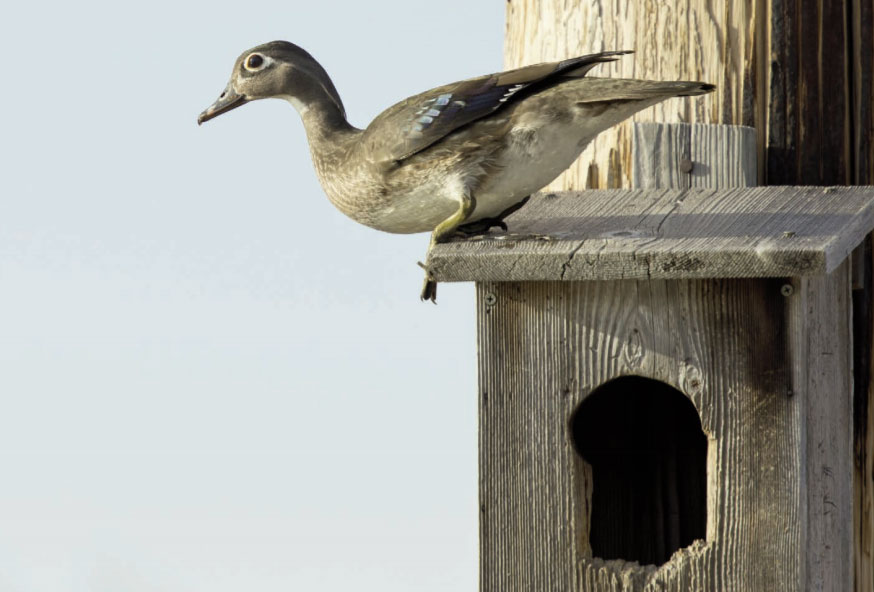
Why Bother with Wood Duck Nest Boxes?
Hunting wood ducks in bottomlands is a unique and special experience, and so is trying to raise ducklings. Even the most seasoned manager has a soft spot for a nesting box full of fuzzy ducklings about to parachute out of their front door and into Mother Nature’s den. But before that can ever happen, careful consideration must be given to wood duck nesting box placement and maintenance, including a fair amount of labor. It’s easy to see how wood duck nesting box programs have increased the wood duck population.
Don’t forget that erecting a wood duck nesting box requires more materials than simply the box itself. While it is true that one can mount a nesting box alone by nailing it to a tree, that method doesn’t provide a measure of protection from common predators like snakes or raccoons. A proper mount includes a 4 X 4 pole of treated lumber and a predator guard usually made of galvanized sheet metal. Nails, screws, hinges and latches are just a few of the smaller hardware pieces that are necessary for final assembly. Don’t forget you will also need nesting materials.
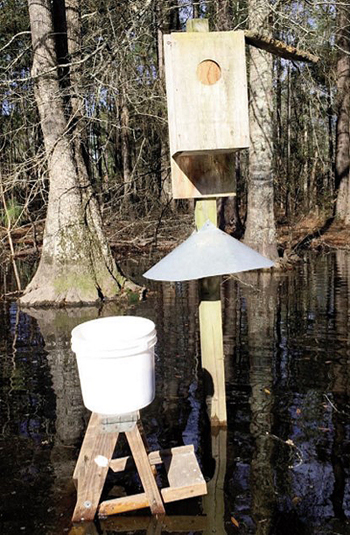
In the Southeast, many refer to wood ducks as summer ducks since they tend to stick around well into spring or even year-round. This fact, plus their willingness to make use of a nest box, makes them a species of duck that can benefit greatly from nesting site management. Make no mistake — some wood ducks migrate to the far North each year, a trek that is documented easily by federal leg band recoveries. However, if you cover their needs, new birds can be coaxed into staying.
The abundance of woodies led the federal government to increase the daily bag limit recently to three per hunter, and their population still has room to improve. Wood ducks used natural tree cavities to nest in before nest boxes were ever implemented, but as hardwood bottomlands became degraded over time by logging efforts, wood duck populations were greatly affected. Wood duck populations today are a conservation success story due to their stable numbers and wide dispersion.
Where?
Identifying areas to place wood duck boxes requires a mixture of scouting and some guesswork. As with all habitat management, working with wood duck boxes will be a trial and error effort since not all box locations will appeal to wood ducks. Any time wood ducks are spotted in flooded wetlands, then that is automatically a spot worthy of consideration for nest box placement. When we hunt ducks, the name of the game is to be where they already want to be, and that knowledge works the same way for nesting activity.
The common sense part of the guesswork comes when you factor in if water will be present at the same spot come late February and into March (or March through May in the North) when the ducklings are being raised in order to fledge. From my experience with putting nest boxes directly on river frontage, I would suggest a different route. The water levels fluctuate each spring so it really doesn’t make for an ideal nesting site. Over time, I became drawn to backwater bays — or what we like to refer to as pocosins in the Southeast — that gather and hold water over winter and also during prolonged wet weather. Potholes or the edge of marshes are also great places. Again, you may have to deal with some trial and error. Wood ducks like to spend their time and raise ducklings in secretive spots in the woods with fair access to water.
Weather can have a big effect when it comes to locating the best locations for a wood duck nest box. A wet and rainy weather cycle makes for a great time to identify potential nest box locations. But just as sure as we are wet during some years, we will be droughty and dry other years, so that’s just part of the equation. Nest boxes might not appeal to wood ducks every year based on conditions, but the emphasis should be on long-term management benefits.
When?
Setting out wood duck boxes in some of these likely locations requires dry conditions in order to use post-hole diggers, or perhaps an auger to set up the 4 x 4 post. It generally is a two-man job to haul the nesting box and the set-up equipment into the woods, making this a great family fun project or maybe just another opportunity to get outside for you and your hunting buddy. A keen woodsman is always ready to absorb knowledge from Mother Nature and these extra trips into the woods can reveal information about other critters, too, such as deer and turkeys.
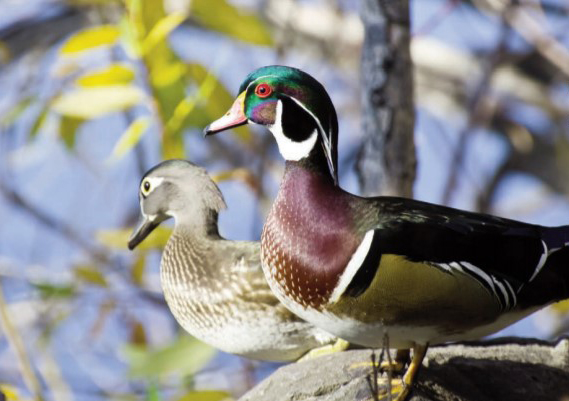
In the North, some like to take advantage of the ice during the winter season to easily access wetland areas that would normally be difficult to approach. Obviously, attaching a house to a tree can be done whenever, but some choose to drill holes in the ice with an auger and use a sledgehammer or post driver to secure a pole on which to hang the wood duck house.
How Do You Install Wood Duck Nest Boxes?
Erecting the nest box is usually a “one and then you’re done” deal with the exceptions being if wood rot occurs or if there’s a change in local hydrology. However, annual maintenance of the nest box is required each winter, usually in early February. When duck hunting season goes out on the last day of January, then the apprehension of entering these water holes and spooking off ducks should diminish. The woodies generally pair up and begin looking for suitable nesting boxes in late February, so the deadline to perform the maintenance here in the Southeast is prior to nesting activity. The same goes for the North – just make sure you’re finished with maintenance before the ducks arrive back from the South and are looking for some new digs.
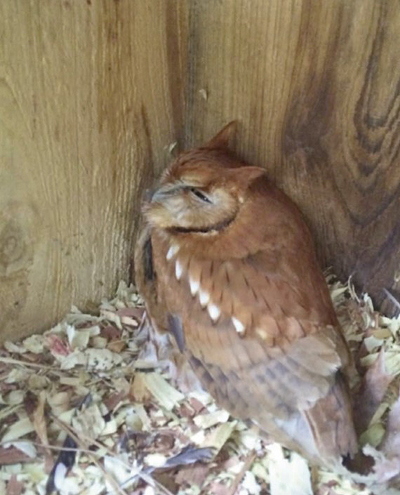
If the hen wood duck inspects a nest box and finds old wood shavings that are compromised with last year’s eggshells and any leftover contents that are now dry and hard, she won’t be staying. A manager must carry fresh wood chips (cedar wood chips are best) to the nest box in order to refill it each winter, and a ladder or climbing sticks must be brought in to reach and open the top of the nest box and gain access to the contents.
Climbing up a ladder, usually in a flooded area, while carrying a sack of wood shavings is where this chore becomes a little more interesting. Managers gain a lot of experience during this phase because a nest box in the woodlands can harbor all sorts of critters such as insects, reptiles and raptors. If the entrance hole is too large, you may even find small mammals have taken it over. Carrying a can of wasp spray is highly recommended, and work gloves won’t be enough to reverse an ant infestation, but they sure help when clearing spider webs.
Box Placement Matters
Don’t overlook the fact that a snake might have gained entrance to the nest box to lurk and to always be watching for things with wings that might flush out the entrance hole. It’s likely a good idea to gently knock on the box with a stick before climbing up into point-blank range, but sometimes critters just stay put so always be on the defensive until the box is open. Falling off a ladder into cold shallow water and flooding one’s hip boots doesn’t sound like fun, but it is a distinct possibility during wood duck box maintenance.
Pruning limbs that are near to the nest box is also part of the annual duties. To prevent varmints and snakes from defeating the predator guard by dropping down from above, make sure to remove low-hanging limbs near the top of the box. Wood ducks like to fly directly into the box on the wing, so keep a clear flight path for them. Wood ducks stick close by when the hen is sitting on eggs so the area around the base of the nest box should also be kept clear of any brush that might invite predators to gather in hopes of an ambush.
Obtaining wood duck boxes can sometimes be made easy by landowner programs in individual states. For instance, in South Carolina, a limited number of free nest boxes are made available for qualified applicants each year, with the Department of Corrections producing the nest boxes. Other options include purchasing wood duck nest boxes from organizations that support conservation. You can often find a place to supply wood duck nest boxes, but typically you are on your own for wood shavings.
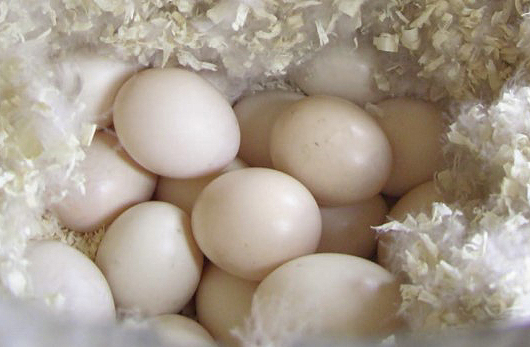
A typical clutch of eggs for wood ducks might range from 12 to 15, but not all of the eggs will hatch. Even less of the yellow fuzzy ducklings that leave the nest box will live, but the survivors are truly raised wild. The drakes will grow up to assume their role as the most handsome duck of the woodlands, and the hens will ensure that woodies remain a sustainable natural resource. This will continue to provide waterfowl hunting opportunities for everyone, with some of the credit going to “the wood duck nest box managers.”
Waterfowl’s Best Friend
When it comes to wetland conservation, many find it a labor of love. It’s a year around effort to improve things like a wood duck nest box, installing a predator guard or keeping raccoons from wreaking havoc on nesting wood ducks. Even more than that, it’s making sure that future generations have waterfowl like wood ducks to hunt. It’s giving back to nature today and putting a down payment on tomorrow’s waterfowl population. It’s one thing to raise a hunter, but we should all strive to make that young hunter a gamekeeper.































